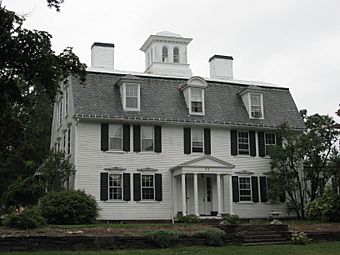The Manse (Northampton, Massachusetts) facts for kids
Quick facts for kids |
|
|
The Manse
|
|

The Manse, 54 Prospect Street
|
|
| Location | 54 Prospect St., Northampton, Massachusetts |
|---|---|
| Area | 1 acre (0.40 ha) |
| Built | 1744 |
| Architectural style | Georgian |
| NRHP reference No. | 76000263 |
| Added to NRHP | October 14, 1976 |
The Manse is a really old and important house in Northampton, Massachusetts. It was built a long time ago, starting in 1744! This house is special because it shows us what buildings looked like in the middle of the 1700s. Many important people from the area have lived here over the years. Because of its history, The Manse was added to the National Register of Historic Places in 1976.
Contents
About The Manse House
The Manse is located in a quiet neighborhood in Northampton. You can find it on Prospect Street. It's a two-story house made of wood.
What Does The Manse Look Like?
The house has a special roof called a gambrel style roof. It looks like a barn roof, with two different slopes on each side. There are two chimneys inside the house.
Three small windows, called dormers, stick out from the roof. The middle dormer has a round top. The other two have sloped tops. A small, square tower, called a cupola, sits right in the middle of the roof.
The oldest part of the house is a two-and-a-half story section at the back. This part was built first!
A Look at The Manse's History
The land where The Manse stands has a very long history. It was first given to a Reverend Solomon Stoddard in the 1600s. A "reverend" is a religious leader, like a pastor.
Reverend Stoddard was the pastor of the first church in Northampton. His house, called a "parsonage," was built here in 1684.
Famous Residents of The Manse
Reverend Stoddard was the grandfather of Jonathan Edwards. Jonathan Edwards was a very important religious leader. He lived in the first house on this land for a short time.
In 1744, Solomon Stoddard's son, John Stoddard, built the back part of the house we see today. John Stoddard was active in local government. He served in the "provincial militia," which was like a local army. He also worked in the "provincial legislature," which made laws for the area.
John's son, also named Solomon, built the front part of the house in 1782. He was the sheriff of Hampshire County.
Other interesting people lived here too!
- Josiah G. Holland was a writer. He also started a magazine called Scribner's Monthly.
- Dr. Benjamin Barrett was an important local politician.
In 1940, a professor from Smith College named Dorothy Douglas bought the house. She helped fix it up and make it look new again. She also asked an artist named Oliver Larkin to paint murals on the walls. Murals are large paintings directly on the walls.



